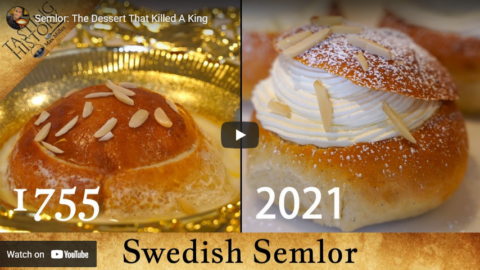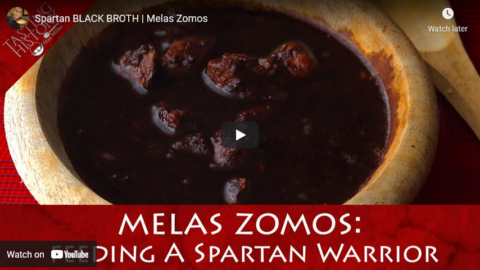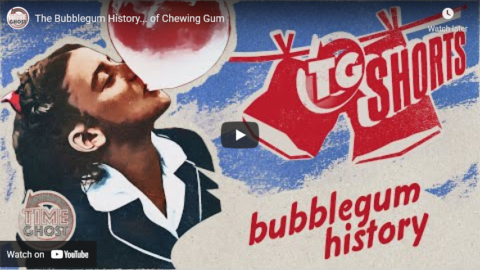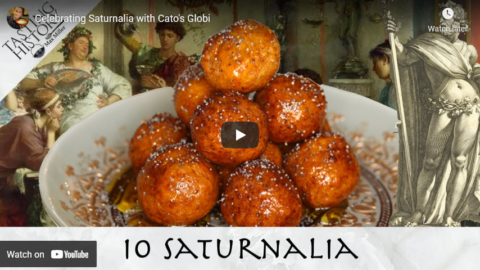Tasting History with Max Miller
Published 16 Feb 2021For information on Svensk Hyllningsfest in Lindsborg, KS, visit https://www.visitlindsborg.com/
Help Support the Channel with Patreon: https://www.patreon.com/tastinghistory
Tasting History Merchandise: crowdmade.com/collections/tastinghistoryFollow Tasting History here:
Instagram: https://www.instagram.com/tastinghist…
Twitter: https://twitter.com/TastingHistory1
Tiktok: TastingHistory
Reddit: r/TastingHistory
Discord: https://discord.gg/d7nbEpyLINKS TO INGREDIENTS & EQUIPMENT**
Sony Alpha 7C Camera: https://amzn.to/2MQbNTK
Sigma 24-70mm f/2.8 Lens: https://amzn.to/35tjyoW
Silpat: https://amzn.to/3rFIFxM
KitchenAid 8-Quart Stand Mixer: https://amzn.to/3cTfbs1LINKS TO SOURCES**
Hjelpreda I Hushållningen För Unga Fruentimber by Cajsa Warg: https://gupea.ub.gu.se/handle/2077/41…
A Journey Through Swedish history by Herman Lindqvist: https://amzn.to/2Z0D3Sb
The world of Cajsa Andersdotter by Bengt Hällgren: https://amzn.to/3jKNMKl**Amazon offers a small commission on products sold through their affiliate links, so each purchase made from this link, whether this product or another, will help to support this channel with no additional cost to you.
Subtitles: Jose Mendoza
#tastinghistory #semlor #semla #fattuesday
February 8, 2022
Semlor: The Dessert That Killed A King
February 7, 2022
American pizza
At An Eccentric Culinary History, H.D. Miller makes a strong case for pizza being more an American dish than an Italian one:
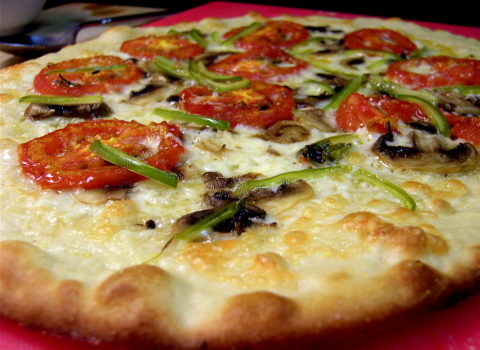
“Pizza” by rdpeyton
Today, standing atop the sprawling edifice that is the American restaurant industry, it’s hard to imagine a time when pizza wasn’t popular. But, prior to World War Two, pizza was barely known in the United States outside of a few Italian enclaves in the Northeast. For all of the praise heaped upon Lombardi’s in New York City, until the war, few people north of Houston Street had heard of it, or the dish it served.
From the mid-19th century forward, there were plenty of Italians in America, in places like New York, New Orleans and San Francisco. Most of those early Italian immigrants — around 75,000 before 1880 — were from northern Italy, not the South, and the restaurants they built were usually serving multi-course, table d’hôte meals of meat, bread, macaroni, wine and coffee at reasonable prices. The model was Caffe Moretti’s in Manhattan. Established in 1858 by Stefano Morretti, an ex-seminarian from the Veneto, Morretti’s offered diners generous portions and cheap prices. It did not, however, offer pizzas.
I have to emphasize this, you couldn’t order a pizza in the vast majority of Italian restaurants in America prior to 1945. And the reason you couldn’t order a pizza in Italian restaurants is because pizza isn’t Italian.
Let me repeat that: Pizza isn’t Italian.
Pizza is Neapolitan. It’s a distinct speciality of Naples, developed at at time when Italy didn’t even exist as a nation. Saying pizza is Italian is like saying haggis is British. It might be technically true, but not really.
As in America, prior to the 1950’s, pizza wasn’t something most Italians knew or cared about. In 1900, there were supposedly no pizzerias in Italy anywhere outside of the medieval walls of Napoli. You couldn’t even get pizza in the suburbs. Pizza was strictly street food for poor people in the crowded tangled alleys near the port. […]
In other words, pizza was not something the average Tuscan, Ligurian or Venetian would have thought suitable for a sit-down meal. Or, if they ever did think of it, it was to revile pizza as oily, unappetizing and a likely vector of cholera. This is because Naples was really famous at the time for being dirty and disease-ridden. (If you’re serious about early pizza history, one that strips away the just-so stories, then go read Inventing the Pizzeria by Antonio Mattozzi.)
What brought pizza to America was the mass immigration of southern Italians between 1880 and 1910, when more than 4 million people moved to the United States. That’s why Lombardi’s didn’t get going until 1905, when there were finally enough Neapolitans in Little Italy to keep the doors open.
The same dynamic played out in South America, in Argentina, Uruguay and Brazil. The first successful pizza restaurant in the world located outside of Naples was founded in Buenos Aires in 1882, when a Neapolitan immigrant baker named Nicolas Vaccarezza started selling the pies out of his shop in Boca. For reference purposes, a decade earlier, an attempt to open a pizzeria in Rome, Italy, had ended in bankruptcy, meaning, at the turn of the last century, you could get a pizza in Buenos Aries, São Paulo or New York, but not in Rome, Florence or Venice.
H/T to Ed Driscoll for the link.
February 1, 2022
Ancient Nian Gao | Lunar New Year Cake
Tasting History with Max Miller
Published 9 Feb 2021Help Support the Channel with Patreon: https://www.patreon.com/tastinghistory
Tasting History Merchandise: crowdmade.com/collections/tastinghistoryFollow Tasting History here:
Instagram: https://www.instagram.com/tastinghist…
Twitter: https://twitter.com/TastingHistory1
Tiktok: TastingHistory
Reddit: r/TastingHistory
Discord: https://discord.gg/d7nbEpyTasting History’s Amazon Wish List: https://amzn.to/3i0mwGt
LINKS TO INGREDIENTS & EQUIPMENT**
Sony Alpha 7C Camera: https://amzn.to/2MQbNTK
Sigma 24-70mm f/2.8 Lens: https://amzn.to/35tjyoW
Glutinous Rice Flour: https://amzn.to/3cxbdFd
Dried Bamboo Leaves: https://amzn.to/3ama0xT
Roast Chestnuts: https://amzn.to/3tc3emZ
Dried Jujubes: https://amzn.to/3aqBrqkLINKS TO SOURCES**
The Annals of Lü Buwei: https://amzn.to/3rfbjFM
Chinese Fairy Tales and Legends by Frederick Martens: https://amzn.to/39BqwLe
Chinese Mythology by Matt Clayton: https://amzn.to/3j6pxpv**Amazon offers a small commission on products sold through their affiliate links, so each purchase made from this link, whether this product or another, will help to support this channel with no additional cost to you.
Subtitles & Ketchup with Max host: Jose Mendoza
PHOTO CREDITS
Pig: By Made by Fanghong – Own work, CC BY 2.5, https://commons.wikimedia.org/w/index…
Rat and Ox: D.h.Isais, CC BY-SA 4.0 https://creativecommons.org/licenses/…, via Wikimedia Commons
Chinese Zodiac Carving: By Jakub Hałun – Own work, CC BY-SA 4.0, https://commons.wikimedia.org/w/index…
Guangdong Niangao: avlxyz from (optional), CC BY-SA 2.0 https://creativecommons.org/licenses/…, via Wikimedia Commons
Hong Kong niangao: Mk2010, CC BY-SA 3.0 https://creativecommons.org/licenses/…, via Wikimedia Commons
Niangao from local Hong Kong: Geoffreyrabbit, CC BY-SA 4.0 https://creativecommons.org/licenses/…, via Wikimedia Commons
Nian gao 2: ProjectManhattan, CC BY-SA 3.0 https://creativecommons.org/licenses/…, via Wikimedia Commons
Chinese New Year Sticky Rice Cakes: ProjectManhattan, CC BY-SA 3.0 https://creativecommons.org/licenses/…, via Wikimedia Commons
Spring and Autumn Period Map: By Yug – Own work, *Background data: ETOPO1 + QGIS > then vectorized using Inkscape *Semantic data: some from Le Monde Chinois, Gernet, p58.or (en:) Gernet (1996) A History of Chinese Civilisation, Cambridge university press, p. 59, CC BY-SA 3.0, https://commons.wikimedia.org/w/index…
Statue of Wu Zixu: By Peter Potrowl – Own work, CC BY 3.0, https://commons.wikimedia.org/w/index…
Bronze DIng: drs2biz, CC BY-SA 2.0 https://creativecommons.org/licenses/…, via Wikimedia Commons
Great Wall at Mutianyu: By J. Samuel Burner – https://www.flickr.com/photos/lobster…, CC BY 2.0, https://commons.wikimedia.org/w/index…MUSIC CREDITS
Music promoted by 1HMNC – No Copyright Music
PeriTune – Folk Chinese https://youtu.be/_FKFunLPksg Folk Chinese by PeriTune (https://soundcloud.com/sei_peridot) is licensed under a Creative Commons License.(CC BY 3.0)#tastinghistory #niangao #chinesenewyear #chinesefood
January 11, 2022
Camden Town Marmite Ale – Weird Stuff In A Can #156
Atomic Shrimp
Published 25 Sep 2021Beer, made with Marmite, which itself is made from the yeast left over when beer was made. Marmite is savoury; beer usually isn’t. This is a weird idea whichever way you look at it, but how does it taste?
From the comments:
Atomic Shrimp
8 hours ago
Afterthoughts & Addenda
uR pOuRiNg iT aLl wRoNg!!! – really? Fine – this might not be a professional perfect pour, but this is *not my first ever beer*. I don’t claim to have any kind of professional technique, but this amount of head is not normal for this method of pouring. Note the copious foam emitting from the can when it is first opened.
January 6, 2022
The war on “ultra-processed food”
Our self-imagined “elites” have a new crusade to prosecute — the crusade against “ultra-processed food”:
In “public health”, the name of the game is to interfere with people’s lives without having your own choices meddled with. This is straightforward with smoking since the philosopher kings of the nanny state don’t smoke. Alcohol is more tricky since most of them drink, but minimum pricing — which was introduced in Ireland yesterday — offers the perfect way to penalise ordinary people while leaving fine wine and craft beer unaffected.
The war on food poses the trickiest problem since its pretext — obesity — is the result of over-consumption and physical inactivity rather than the consumption of any specific type of food. “Junk food” is too narrow since most people interpret it to mean “fast food” from a handful of restaurant chains. And so, in the absence of an obvious dietary culprit, the “public health” lobby is shifting towards a crusade against “ultra-processed food”.
Most people don’t know what this means, but it sounds bad if you have an instinctive objection to industry and modernity. Perhaps it evokes thoughts of “chemicals” and “E numbers”. Certainly, it sounds like the opposite of the “natural”, “organic” and “home made” food so beloved of those who think they are superior to other people. It is, however, a classic “public health” bait and switch. Just as people didn’t realise that a ban on “junk food” advertising would result in adverts for cheese and butter being banned, people won’t realise what a war on ultra-processed food means for them until it is too late.
In a deranged op-ed in BMJ Global Health, some of Mike Bloomberg’s minions from Vital Strategies call for tobacco-style regulation of “ultra-processed food”, starting with warning labels.
Simply put, ultra-processed foods are foods that can’t be made in your home kitchen because they have been chemically or physically transformed using industrial processes. They are recognisable on the supermarket shelf as packaged foods that are ready-to-eat, contain more than five ingredients and have a long shelf-life. The industrial processing, as well as the cocktail of additives, flavours, emulsifiers and colours they contain to give flavour and texture, make the final product hyper-palatable or more appealing and potentially addictive, which in turn leads to poor dietary patterns.
With more than half the total calories consumed in high-income countries coming from ultra-processed foods and rapid increases in low- and middle-income countries, these products are exposing billions of people to a higher risk of type 2 diabetes, heart disease, stroke, depression and death.
Scary stuff, eh? Alas, they don’t give any examples of ultra-processed foods so let us instead turn to a recently published study about them …
Baked goods, including cakes, pastries, industrial breads, and soft drinks ranked among the top contributors to sales of UPFDs [ultra-processed food and drinks]
According to the the British Heart Foundation, ultra-processed foods include …
Ice cream, ham, sausages, crisps, mass-produced bread, breakfast cereals, biscuits, carbonated drinks, fruit-flavoured yogurts, instant soups, and some alcoholic drinks including whisky, gin, and rum.
I’m not sure how hard liquor made the cut, but I suppose if you’re going be a fun sponge you might as well go all the way.
January 5, 2022
Spartan BLACK BROTH | Melas Zomos
Tasting History with Max Miller
Published 6 Oct 2020If you’ve ever wanted to be a Spartan warrior, then making a bowl of Melas Zomos is just a part of the process. Today, I cover each step in making both Melas Zomos and in making a Spartan warrior.
Follow Tasting History here:
Instagram: https://www.instagram.com/tastinghist…
Twitter: https://twitter.com/TastingHistory1
Reddit: r/TastingHistoryHelp Support the Channel with Patreon: https://www.patreon.com/tastinghistory
LINKS TO INGREDIENTS & EQUIPMENT**
Canon EOS M50 Camera: https://amzn.to/3amjvwu
Canon EF 50mm Lens: https://amzn.to/3iCrkB8
All-Clad Stock Pot: https://amzn.to/32HsYMx
Bay Leaves: https://amzn.to/33DnaTP
KitchenAid Blender: https://amzn.to/2RBkWi4LINKS TO SOURCES**
The Spartans by Paul Cartledge: https://amzn.to/35Jd2vo
Plutarch On Sparta: https://amzn.to/2H6SBhy
The Deipnosophistai by Athenaeus: https://amzn.to/3my5v8D
The Histories by Herodotus: https://amzn.to/32NdcQF
A Companion to Sparta by Anton Powell: https://amzn.to/3c94PSq
The Rise of the Greek Aristocratic Banquet by Marek Wecowski: https://amzn.to/2RFD5LK
Sparta Reconsidered by Helena P. Schrader: https://bit.ly/32FQOIM**Amazon offers a small commission on products sold through their affiliate links, so each purchase made from this link, whether this product or another, will help to support this channel with no additional cost to you.
MELAS ZOMOS
INGREDIENTS
– 2lb (1kg) Pig Leg (or other pork product)
– 2 Cups (1/2 liter) Pig Blood
– 1 Cup (235ml) White Wine Vinegar
– 2 Tablespoons Olive Oil
– 1 Tsp Salt
– 4 Cups (1 Litre) Water
– 3 Bay Leaf
– 1 Large Chopped OnionMETHOD
1. Set a large stock pot over medium heat, then add the olive oil and onions and cook until tender and lightly brown, about 10 minutes.
2. Add the chopped pork to the pot book for another 10 minutes.
3. Pour in the vinegar and 3-4 cups of water (4 if you have fresh pig’s blood, 3 if you have coagulated blood), the salt and the bay leaves. Once boiling, lower the heat to medium low and let the soup simmer, covered, for 45 minutes to and hour or until the pork is cooked through.
4. Add the pork blood* and simmer for 15 minutes more, then serve.
*If you are using coagulated pork blood, mix it with the final cup of water in a blender and blend until most of it is liquid. Strain out any large chunks and add the liquid to the soup.PHOTO CREDITS
Symposium Scene: Marie-Lan Nguyen / https://bit.ly/3muYyoI
Schwarzsauer: Overbergderivative work / https://bit.ly/2ZJxBUq
Dinuguan with puto: Lambanog / https://bit.ly/3mrLyAg
Odaker: https://bit.ly/2ZKFRUi
Plutarch Bust: Odyssey / https://bit.ly/2FAYO54
Roman mosaic from Dougga: Pascal Radigue / https://bit.ly/2E6Wu4Y
Greek Vase with Child: National Archaeological Museum of Athens / https://bit.ly/2H04tlo
Sarcophagus Marcus Cornelius Statius: Louvre Museum / https://bit.ly/2ZK3bla
Dionysus with Hermes on Jug: MatthiasKabel – https://bit.ly/2FECCqL
Mt Taygetus: Gepsimos – https://bit.ly/32A4SU8
Eurotas River: Gepsimos / https://bit.ly/2Fv4AVY
Xerxes: Darafsh / https://bit.ly/2H0lWds
January 2, 2022
Eat the bugs, peasants! Leave the meat for your betters!
Andrew Orlowski on the self-imagined elite attitudes to the environment and — as a direct result — the growing chorus of journalists pushing the idea of substituting plant-based synthetics and/or insects in place of meat for us proles:
In recent years, media messaging has been emphatically bossy about what we should eat. State micromanagement of taste has increased, too. After government intervention, British staples ranging from sticky-toffee pudding to Sugar Puffs have been reformulated beyond recognition. But the anti-meat crusade demands that something far more radical should happen – it seeks to stigmatise something central to many of our lives, and demands a shift in how we regard nature. As part of this, our media now seek to normalise lab-grown Frankenmeats, and strangest of all, adopt entomophagy – the practice of eating insects.
So what’s behind the war on meat? The apparent justification is the political elite’s great preoccupation of our time – climate change. We’re told that rearing livestock for meat is bad for the environment, and that cows are the worst offenders of all. That’s the assumption behind hit YouTube videos like Mark Rober’s “Feeding Bill Gates a fake burger (to save the world)”, a promotional video for Gates’ synthetic-meat investments, which has racked up nearly 46million views.
But the environmental argument doesn’t look so robust on closer examination. Agricultural CO2 emissions are small – so small that if the United States turned entirely vegan this decade, it would lower US emissions by just 2.6 per cent. In reality, a cow is a highly efficient protein-conversion system, turning protein that we can’t eat into protein that we love to eat. Three quarters of livestock, on balance, improve the environment, enhancing the yield of the land through fertiliser, which would otherwise need to be made synthetically. For example, one of the crimes regularly levelled against beef is water consumption. But the cow loses most of this water the same day – it’s returned to nature. So with environmental claims so weak, there must be some other rationale for the war on meat.
Much of today’s war on meat appears to be driven by venture capitalists, and their client journalists in the media. Ever eager for the next dot-com boom, Silicon Valley has made a bet on lab-grown, synthetic meat. This requires an industrial bioreactor – an expensive chemical process. But lab-grown meat doesn’t seem to be going anywhere. Business Insider recently reported that scepticism about the sector is growing, as costs remain higher than those for real meat – and this is before one single laboratory-meat formula has received regulatory approval, let alone passed the consumer test.
Another factor driving the war on meat is the academic blob. For example, Professor Peter Smith, an environmental scientist at Aberdeen University and a leading contributor to the UN’s Intergovernmental Panel on Climate Change (IPCC), likes to insist that “we’re not telling people to stop eating meat”, before adding that “it’s obvious that in the West we’re eating far too much”. Have a guess who defines what is “too much”. It’s Smith and his colleagues, not you or me making informed consumer choices.
But the oddest spectacle of all is the relentless promotion of entomophagy at the posh end of the media. The posher the paper, the keener they are on normalising bug-eating.
This is a campaign that has a high hurdle to overcome in most markets, where insects are associated with disease. “Deeply embedded in the Western psyche is a view of insects as dirty, disgusting and dangerous”, a group of academics found in 2014. Many bugs, such as cockroaches, carry disease. Flies like shit, as the saying goes. “Individuals vary in their sensitivity to disgust”, another academic paper acknowledges. “This sensitivity extends to three dimensions of disgust: core, animal reminder and contamination.” Only seven per cent of the US population would countenance the idea of eating insects, even in powdered form, according to one academic study in 2018. Processing insects also raises practical problems, with e-coli and salmonella. “Spore-forming bacteria and enterobacteriaceae have been reported in mealworms and crickets, with higher levels found in insects that had been crushed – likely due to the release of bacteria from the gut”, another study found. It’s easier to clean a cow’s stomach than a cockroach’s.
It should be no surprise, then, that the edible-insect movement has hit a few snags. Blythman recalls the startup, Eat Grub (geddit?), providing the snacks for an insect pop-up in London’s hipster East End. On the menu were “Thai-inspired” creations such as spicy cricket rice cakes and buffalo worms wrapped in betel leaf. “It tasted disgusting, and so I swallowed it whole. Then the legs stuck in my throat”, she recalls. The pop-up hasn’t returned. The following year, Sainsbury’s tapped Eat Grub for its first range of insect products – barbeque-flavoured crickets. Today, the only crickets you can buy at Sainsbury’s are cigarette lighters.
January 1, 2022
A 4000 Year Old Recipe for the Babylonian New Year
Tasting History with Max Miller
Published 29 Dec 2020Help Support the Channel with Patreon: https://www.patreon.com/tastinghistory
Tasting History Merchandise: crowdmade.com/collections/tastinghistoryFor further reading on these recipes visit: https://www.academia.edu/40639453/Foo…
Follow Tasting History here:
Instagram: https://www.instagram.com/tastinghist…
Twitter: https://twitter.com/TastingHistory1
Reddit: r/TastingHistory
Discord: https://discord.gg/d7nbEpyTasting History’s Amazon Wish List: https://www.amazon.com/hz/wishlist/ls…
LINKS TO INGREDIENTS & EQUIPMENT**
Canon EOS M50 Camera: https://amzn.to/3amjvwu
Canon EF 50mm Lens: https://amzn.to/3iCrkB8
Le Creuset Dutch Oven 7.25 qt: https://amzn.to/3mLkWJFLINKS TO SOURCES**
https://www.academia.edu/40639453/Foo…
Gojko Barjamovic: https://nelc.fas.harvard.edu/people/g…
Myths from Mesopotamia translated by Stephanie Dalley: https://amzn.to/2Kvzr7b
Babylon by Paul Kriwaczek: https://amzn.to/37GJRJT
The Oldest Cuisine in the World by Jean Bottéro: https://amzn.to/2Jf1eIm
The Babylonian Akitu Festival by Svend Aage Pallis: https://amzn.to/2M5hZa7
The Babylonian New Year Festival by Karel Van Der Toorn: https://brill.com/view/book/edcoll/97…**Amazon offers a small commission on products sold through their affiliate links, so each purchase made from this link, whether this product or another, will help to support this channel with no additional cost to you.
Editor: WarwicSN – https://www.youtube.com/WarwicSN
Subtitles: Jose MendozaDISH NAME
ORIGINAL c.1740BC RECIPE (From The Yale Babylonian Tablets)
Tuh’u sirum saqum izzaz me tukan lipia tanaddi tusammat tabatum sikara susikillum egegerum kisibirrum smidu kamunum alutum tukammas-ma karsum hazannum teterri kisibirrum ina muhhi sipki tusappah suhutinnu kisibirrum isarutu tanaddi.Tuh’u. Lamb leg meat is used. Prepare water. Add fat. Sear. Add in salt, beer, onion, arugula, cilantro, samidu, cumin, and beets. Put the ingredients in the cooking vessel and add crushed leek and garlic. Sprinkle the cooked mixture with coriander on top. Add suhutinnu and fresh cilantro.
MODERN RECIPE
INGREDIENTS
– 1lb (450g) Leg of Lamb Chopped into bite size pieces.
– 3-4 Tablespoon Oil or Rendered Fat
– 1 ½ teaspoons Salt
– 2 Cups (475ml) Water
– 12 oz (350ml) Beer – (A sour beer and German Weissbier are recommended, but any non-hoppy beer will suffice)
– 1 Large Onion Chopped
– 2 Cups Arugula Chopped
– 3/4 Cup Cilantro Chopped
– 2 Teaspoons Cumin Seeds crushed
– 2 Large Beets (approx. 4 cups) Chopped
– 1 Large Leek Minced
– 3 cloves Garlic,
– 1 Tablespoon Dry Coriander Seeds
– Additional Chopped Cilantro for garnish
– Samidu* (Something akin to 1 Persian Shallot)
– Suhutinnu* (Something akin to Egyptian Leek for garnish)
*These ingredients have no definite translation; the shallot and leek are the best guesses of scholars at Yale and Harvard Universities)METHOD
1. Add the oil/fat to a large pot and set over high heat. Sear the lamb for several minutes in the oil until lightly browned.
2. Add the onions and let cook for 5 minutes, then add the beets and let cook for 5 minutes. Then add the salt, beer, arugula, cilantro, samidu (shallot) and cumin and bring to a boil. Mash the garlic into a paste and mix with the leek, then add to the pot.
3. Lower heat to medium and let simmer for approximately 1 hour, or until the beets and meat are cooked to your liking.
4. Once cooked, dish it into a bowl and sprinkle with coriander seeds. Garnish with fresh cilantro and suhutinnu (leek)PHOTO CREDITS
Crocus: By Safa.daneshvar – Own work, CC BY-SA 3.0, http://bit.ly/3hfNN7F
Statue of Nabu: By Osama Shukir Muhammed Amin FRCP(Glasg) – Own work, CC BY-SA 4.0, http://bit.ly/2KodVkV
Temple of Nabu at Borsippa: Osama Shukir Muhammed Amin FRCP(Glasg), CC BY-SA 4.0 https://creativecommons.org/licenses/…, via Wikimedia Commons
Ishtar Gate: Joyofmuseums, CC BY-SA 4.0 https://creativecommons.org/licenses/…, via Wikimedia Commons
King Marduk-zakir-shumi: By Osama Shukir Muhammed Amin FRCP(Glasg)Throne Dais of Shalmaneser III at the Iraq Museum.jpg, CC BY 4.0, http://bit.ly/3nMw22j#tastinghistory #babylon #akitu
December 31, 2021
Hogmanay Shortbread from 1779
Tasting History with Max Miller
Published 28 Dec 2021Use my exclusive link here https://cen.yt/TastingHistory5 to get $15 off your first three bags.
Support the Channel with Patreon ► https://www.patreon.com/tastinghistory
Merch ► crowdmade.com/collections/tastinghistory
Instagram ► https://www.instagram.com/tastinghist…
Twitter ► https://twitter.com/TastingHistory1
Tiktok ► TastingHistory
Reddit ► r/TastingHistory
Discord ► https://discord.gg/d7nbEpy
Amazon Wish List ► https://amzn.to/3i0mwGtSend mail to:
Tasting History
PO Box 766
Burbank, CA 91503LINKS TO SOURCES**
Cookery, and Pastry, as Taught and Practised by Mrs Maciver by Susanna Maciver: https://amzn.to/3EmSPcm
The Little Book of Hogmanay by Bob Pegg: https://amzn.to/30RAmqO**Some of the links and other products that appear on this video are from companies which Tasting History will earn an affiliate commission or referral bonus. Each purchase made from these links will help to support this channel with no additional cost to you. The content in this video is accurate as of the posting date. Some of the offers mentioned may no longer be available.
Subtitles: Jose Mendoza | IG @ worldagainstjose
PHOTO CREDITS
Shortbread fingers: Dave Souza – Own work, CC BY-SA 2.5, https://commons.wikimedia.org/w/index…
Black Bun: IMBJR, CC BY-SA 3.0 https://creativecommons.org/licenses/…, via Wikimedia CommonsMUSIC CREDIT
“Achaidh Cheide – Celtic” by Kevin MacLeod is licensed under a Creative Commons Attribution 4.0 license. https://creativecommons.org/licenses/…
Source: http://incompetech.com/music/royalty-…
Artist: http://incompetech.com/#tastinghistory #hogmanay #shortbread
December 28, 2021
The Bubblegum History … of Chewing Gum
TimeGhost History
Published 27 Dec 2021Ancient Finns, angry Ottomans, a one-legged Mexican general, and scouring soap — that’s the story of modern chewing gum in a nutshell!
Hosted by: Indy Neidell and Spartacus Olsson
Written by: Indy Neidell
Director: Astrid Deinhard
Producers: Astrid Deinhard and Spartacus Olsson
Executive Producers: Astrid Deinhard, Indy Neidell, Spartacus Olsson, Bodo Rittenauer
Creative Producer: Maria Kyhle
Post-Production Director: Wieke Kapteijns
Edited by: Karolina Dołęga
Sound design: Marek KamińskiSources:
– Birch Bark photo courtesy of Jerzy Opioła https://commons.wikimedia.org/wiki/Fi…
– Mastic tears photo courtesy of פארוק https://en.wikipedia.org/wiki/Mastic_…
– Mexican Cession map courtesy of Kballen https://commons.wikimedia.org/wiki/Fi…
– Peter Gabriel, Chateau Neuf, Oslo, Norway courtesty of Helge Øverås https://en.wikipedia.org/wiki/File:Pe…
– Promotional Chiclets courtesy of Coolshans https://commons.wikimedia.org/wiki/Fi…Soundtracks from Epidemic Sound:
– “Ancient Saga” – Max Anson
– “Master of the Hurricane” – Rockin’ For Decades
– “Home on the Prairie” – Sight of Wonders
– “Cocktail Hour” – The Fly Guy FiveArchive by Screenocean/Reuters https://www.screenocean.com.
A TimeGhost chronological documentary produced by OnLion Entertainment GmbH.
December 27, 2021
Celebrating Saturnalia with Cato’s Globi
Tasting History with Max Miller
Published 15 Dec 2020Help Support the Channel with Patreon: https://www.patreon.com/tastinghistory
Tasting History Merchandise: crowdmade.com/collections/tastinghistoryFollow Tasting History here:
Instagram: https://www.instagram.com/tastinghist…
Twitter: https://twitter.com/TastingHistory1
Reddit: r/TastingHistory
Discord: https://discord.gg/d7nbEpyLINKS TO INGREDIENTS & EQUIPMENT**
Canon EOS M50 Camera: https://amzn.to/3amjvwu
Canon EF 50mm Lens: https://amzn.to/3iCrkB8
Safflower Oil: https://amzn.to/39Lcsiz
Spelt Flour: https://amzn.to/3ggzPBO
Poppy Seeds: https://amzn.to/37DyG3q
Pokemon plushie: www.pokemoncenter.comLINKS TO SOURCES**
De Agricultura by Cato the Elder: https://amzn.to/3qxL5P5
Saturnalia by Macrobius: https://amzn.to/39N6Pkb
The Twelve Ceasars by Seutonius: https://amzn.to/39MQBat
**Amazon offers a small commission on products sold through their affiliate links, so each purchase made from this link, whether this product or another, will help to support this channel with no additional cost to you.Subtitles: Jose Mendoza
GLOBI
ORIGINAL 2ND CENTURY BC RECIPE (From De Agricultura by Cato the Elder)
Globi to be made thus: Mix the cheese and spelt in the same way. Make as many as desired. Pour fat into a hot copper vessel, and fry one or two at a time, turning them frequently with two sticks, and remove when done. Coat with honey, sprinkle with poppy-seeds, and serve.MODERN RECIPE
INGREDIENTS
– 1 Cup (240g) Ricotta Cheese
– 1 Cup and 1 tablespoon (120g) Spelt, Durum or other whole grain flour
– 1 Quart (1 L) of fat or oil
– 1/3 Cup (80ml) Honey
– Poppy SeedsMETHOD
1. Mix the cheese and flour in a large bowl, then form it into balls about 1 inch across. This recipe should make 12-15 balls.
2. Heat the oil over a high heat until it reaches 350°F (175°C). Turn heat to medium and fry two to three balls at a time, turning every 10 to 15 seconds with tongs. At 60 seconds, begin to check the color; once they are a golden brown (60-90 seconds) take them out and set them on a wire rack over paper towels to drain. Repeat until all of the globi are fried.
3. Dip the dried globi in honey (heating the honey can help if it is too thick). Then sprinkle with poppy seeds and serve.PHOTO CREDITS
Saturn: By inconnu – User:Jean-Pol GRANDMONT (2011), CC BY 3.0, https://bit.ly/39OKgLF
A Statue of Chronos: By Rufus46 – Own work, CC BY-SA 3.0, https://bit.ly/3giv9eH
Pileus: By Marie-Lan Nguyen (2009), CC BY 2.5, https://bit.ly/3osYo1l
Roman Collared Slaves: Ashmolean Museum, CC BY-SA 2.0 https://bit.ly/36OoIgz
Candles Oberflacht: Landesmuseum Württemberg, CC BY-SA 3.0 https://bit.ly/2Lf9yZp
Roman Figurines: Carole Raddato from FRANKFURT, Germany, CC BY-SA 2.0 https://creativecommons.org/licenses/…#tastinghistory #saturnalia #globi #romancooking
December 26, 2021
You Suck at Christmas – You Suck at Cooking (episode 28)
You Suck At Cooking
Published 23 Dec 2015A 100 percent full throttle high adrenaline speed chase through the history of christmas.
Wishing you all a great close to your year!
December 22, 2021
Rum Balls Recipe – Christmas Cookie Special! Chocolate Rum Balls
Food Wishes
Published 7 Dec 2011Learn how to make a Chocolate Rum Balls Recipe! Visit http://foodwishes.blogspot.com/2011/1… for the ingredients, more recipe information, and over 650 additional original video recipes! I hope you enjoy this Christmas Cookie Special – Chocolate Rum Balls Recipe!
QotD: Sibling rivalry
It’s only natural to feel competitive with your siblings. I recall all of those Christmas mornings, as my brother and sister and I compared gifts to figure out which one of us was the least beloved. This was important information because we adjusted our levels of misbehavior to match the rewards. There’s no point in being extra good if the presents are just okay.
Mealtime was competitive too. The winner was the one who moved the greatest percentage of my father’s income through his or her digestive system. I was in my thirties before someone told me that eating is not a speed sport.
Scott Adams, Dilbert Newsletter 61.0, 2005-10-25.
December 21, 2021
Figgy Pudding | A Victorian Christmas Tradition
Tasting History with Max Miller
Published 1 Dec 2020Help Support the Channel with Patreon: https://www.patreon.com/tastinghistory
Tasting History Merchandise: https://bit.ly/3oLyAhWFollow Tasting History here:
Instagram: https://www.instagram.com/tastinghist…
Twitter: https://twitter.com/TastingHistory1
Reddit: r/TastingHistory
Discord: https://discord.gg/d7nbEpyLINKS TO INGREDIENTS & EQUIPMENT**
Canon EOS M50 Camera: https://amzn.to/3amjvwu
Canon EF 50mm Lens: https://amzn.to/3iCrkB8
Pudding Cloth: https://amzn.to/3nFIvnX
Beef Suet: https://amzn.to/3pN4Xx9
Currants: https://amzn.to/36Rh5ojLINKS TO SOURCES**
Modern Cookery by Eliza Acton: https://amzn.to/2HlVCLA
A Christmas Carol: https://amzn.to/3kNguJp
The Battle for Christmas by Stephen Nissenbaum: https://amzn.to/3kQZ7aq
Household Words: A Weekly Journal, Vol 2 – https://bit.ly/2IuJ2Ke
Good Housekeeping, Volumes 5-6: https://bit.ly/32F2SJS**Amazon offers a small commission on products sold through their affiliate links, so each purchase made from this link, whether this product or another, will help to support this channel with no additional cost to you.
Subtitles: Jose Mendoza
DISH NAME
ORIGINAL 1845 RECIPE (From Modern Cookery for Private Families)
The Author’s Christmas Pudding.
To three ounces of flour, and the same weight of fine, lightly-grated bread-crumbs, add six of beef kidney-suet, chopped small, six of raisins weighed after they are stoned, six of well-cleaned currants, four ounces of minced apples, five of sugar, two of candied orange-rind, half a teaspoonful of nutmeg mixed with pounded mace, a very little salt, a small glass of brandy, and three whole eggs. Mix and beat these ingredients well together, tie them tightly in a thickly floured cloth, and boil them for three hours and a half. We can recommend this as a remarkably light small rich pudding: it may be served with German wine, or punch sauce.MODERN RECIPE
INGREDIENTS
– 3 oz (85g) Flour
– 3 oz (85g) Bread Crumbs
– 6 oz (170g) Beef Suet (Lard or Crisco will work as well)
– 6 oz (170g) stoned Raisins
– 6 oz (170g) Currants
– 4 oz (113g) Minced Apples
– 5 oz (142g) Brown Sugar
– 2 oz (57g) Candied Peel
– ½ teaspoon Nutmeg and mace
– A few grains of Salt
– 3 oz (88ml) Brandy
– 3 EggsMETHOD
1. Boil the pudding cloth for 20 minutes. Then carefully remove it from the pot and lay it out flat. Spread suet, lard or butter across it and rub in a liberal amount of flour.
2. Combine all ingredients in a large bowl and mix. Then form into a ball and place in the middle of the pudding cloth. Gathering the cloth tightly around it, twist the cloth at the “neck” then wrap it with a string several times and tie tightly around it.
3. Boil a large pot of water with an upside down plate on the bottom of the pot. Set the pudding in the boiling water and let boil for 3 1/2 hours. Check often and add more boiling water when necessary.
4. Remove pudding from the water and allow to dry before unwrapping. This can be served right away or aged for several weeks/months.Punch sauce for Sweet Puddings
This may be served with custard, plain bread, and plum-puddings. With two ounces of sugar and a quarter of a pint of water, boil very gently the rind of half a small lemon, and somewhat less of orange-peel, from fifteen to twenty minutes; strain out the rinds, thicken the sauce with an ounce and a half of butter and nearly a teaspoonful of flour, add a half-glass of brandy, the same of white wine, two thirds of a glass of rum, with the juice of half an orange, and rather less of lemon-juice: serve the sauce very hot, but do not allow it to boil after the spirit is stirred in.
– 2oz Sugar
– ¼ pint Water
– Lemon & Orange Rind
– 1 ½ oz Butter
– 1 Teaspoon Flour
– ½ Wineglassful Brandy
– ½ Wineglassful White Wine
– ⅔ Wineglassful Rum
– Orange & Lemon JuiceMUSIC CREDITS
“We Wish You a Merry Christmas” by Twin Musicom is licensed under a Creative Commons Attribution 4.0 license. https://creativecommons.org/licenses/…
Artist: http://www.twinmusicom.org/“Angels We Have Heard – Christmas” by Kevin MacLeod is licensed under a Creative Commons Attribution 4.0 license. https://creativecommons.org/licenses/…
Source: http://incompetech.com/music/royalty-…
Artist: http://incompetech.com/“Rondo for harp” – Mike Harper
#tastinghistory #christmaspudding #figgypudding

